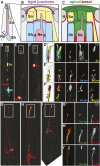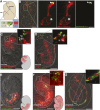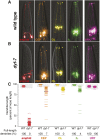Morphogenesis of neurons and glia within an epithelium
- PMID: 30683663
- PMCID: PMC6398450
- DOI: 10.1242/dev.171124
Morphogenesis of neurons and glia within an epithelium
Abstract
To sense the outside world, some neurons protrude across epithelia, the cellular barriers that line every surface of our bodies. To study the morphogenesis of such neurons, we examined the C. elegans amphid, in which dendrites protrude through a glial channel at the nose. During development, amphid dendrites extend by attaching to the nose via DYF-7, a type of protein typically found in epithelial apical ECM. Here, we show that amphid neurons and glia exhibit epithelial properties, including tight junctions and apical-basal polarity, and develop in a manner resembling other epithelia. We find that DYF-7 is a fibril-forming apical ECM component that promotes formation of the tube-shaped glial channel, reminiscent of roles for apical ECM in other narrow epithelial tubes. We also identify a requirement for FRM-2, a homolog of EPBL15/moe/Yurt that promotes epithelial integrity in other systems. Finally, we show that other environmentally exposed neurons share a requirement for DYF-7. Together, our results suggest that these neurons and glia can be viewed as part of an epithelium continuous with the skin, and are shaped by mechanisms shared with other epithelia.
Keywords: Amphid; C. elegans; Dendrites; Glia; Neurodevelopment; Sensory epithelia.
© 2019. Published by The Company of Biologists Ltd.
Conflict of interest statement
Competing interestsThe authors declare no competing or financial interests.
Figures






References
Publication types
MeSH terms
Substances
Grants and funding
LinkOut - more resources
Full Text Sources
Other Literature Sources

